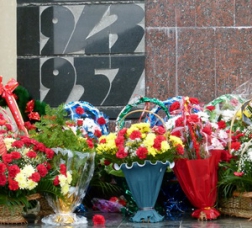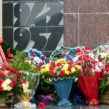
Ethnic Abaza React to Rising Karachai Nationalism
Publication: Eurasia Daily Monitor Volume: 10 Issue: 92
By:

On May 3, groups of Karachay and Abaza youth clashed in Karachaevo-Cherkessia. According to a member of the Abaza organization, Janibek Kuzhev, the fight took place in the village of Psyzh in Abazin district of Karachaevo-Cherkessia. As Karachay youth tried to intimidatingly drive through the village in 30 cars, the Abaza youth blocked their way, not allowing them to pass. The Karachays, celebrating the Day of Karachay People’s Revival, had reportedly attempted to enter the village at midnight. The Abaza activists said that last year the Karachay youth entered their village late at night and chanted provocative nationalist slogans. This year, as young people on both sides prepared for the encounter, the incident led to a confrontation and reverted to a fistfight that was stopped by the police (https://www.kavkaz-uzel.ru/articles/223785/).
Deputy Interior Minister of Karachaevo-Cherkessia Boris Erkenov denied the clash took place in the district, saying that the police prevented this from happening and that “nothing special happened on May 3.” Yet, the head of Karachaevo-Cherkessia, Rashid Temrezov, condemned the attempt of the Karachay youth to march on Psyzh village. “When all the republic was celebrating the Day of Karachay People’s Revival, it has a unifying nature for all peoples of the republic. A group of young people, presumably from Ust-Jeguta district, totally blocked traffic in the republic’s capital and then for some reason went to the village of Psyzh of Abaza district. Serious trespasses against public order and traffic regulations occurred,” said the head of the republic at a governmental meeting (https://www.kavkaz-uzel.ru/articles/223822/). Ethnic Karachays were sent en masse into exile to Central Asia by Joseph Stalin in 1943 for alleged mass collaboration with the Germans. After their rehabilitation in the post-Stalin Soviet Union and later in the post-Soviet era, the Karachays have marked the return to their homeland by celebrating the Day of Karachay People’s Revival in the republic.
Periodic incidents of marches of one ethnic group through the perceived “canonical” territory of another ethnic group strikingly resemble similar trends in Northern Ireland where Catholics and Protestant communities have repeated disputes of the same kind. The inter-ethnic situation in Karachaevo-Cherkessia has never been without some problems in the past two decades, but reports of ethnic clashes in the republic occur more often now, than several years ago. This republic is the second most ethnically diverse in the North Caucasus after Dagestan. Ethnic Abaza, who are related both to the Circassians and to the Abkhaz, comprise about 8 percent of the population of the republic. Ethnic Karachays comprise the plurality in the republic with 41 percent of the republican population. Karachays are followed by a large, but politically powerless, Russian population of 32 percent. The Circassians (Cherkess) make up the remaining 12 percent of the republican population. Ethnic Nogais are another indigenous ethnic group in the republic and comprises a little over 3 percent of the total population of Karachaevo-Cherkessia.
In August 2012, police officials of Karachay ethnicity in Karachaevo-Cherkessia clashed with a group of Circassian youth that marched through republican capital city, Cherkessk. The police officers reportedly fired their guns in the air and were confronted by defiant Circassians. At the time, Circassian organizations warned that the continuation of what they regarded as discriminatory policies of the Karachay elites toward ethnic Circassians may lead to a destabilization of the situation in the republic and beyond (https://natpress.net/index.php?newsid=9374).
Ethnic clashes and general instability are not something unfamiliar to the residents of Karachaevo-Cherkessia. During the 1999 local presidential elections, the Karachay and Circassian communities of the republic nearly went to war with each other over the position of the republican president. In 2004, protesters stormed government building in Cherkessk and occupied the office of the then-president of the republic, Mustafa Batdyev, for several days, demanding his resignation. Batdyev’s son-in-law was implicated in a killing of a group of local businessmen that the Karachaevo-Cherkessian government failed to investigate until the civil unrest exploded (https://www.ng.ru/regions/2004-11-11/1_batdyev.html).
The development of the nationalities policy in Karachaevo-Cherkessia took a markedly different turn in comparison to Dagestan. In Dagestan, ethnic groups live in ethnically mixed districts and towns, especially in the lowlands where the majority of the republican population resides. Ethnic minorities’ demands to allow them have some form of administrative autonomy within Dagestan do not find support in the government. Whereas, in Karachaevo-Cherkessia, the government chose to support its ethnic minorities’ claims for their own ethnic territories.
In 2006, the Abaza district was officially established near the capital city of Cherkessk. While the district contains only five villages, it has a population of 17,000 people, which comprises less than half of the total Abaza population residing in the entire republic. In 2007, the Nogai district was established in the northern part of the republic that has a substantial population of ethnic Nogais. The Nogai district is also small, made up of about 16,000 people and five rural settlements. The creation of the districts for minorities apparently appeased them to some extent, but it is not known yet how this will affect the republic’s ethnic situation in the long run.
As the latest incidents show, the ethnic enclaves of minorities are perceived by the minorities themselves and outsiders as ethnic fortresses and enclaves similar to the various ethnic pockets found in the Balkans. As in the Balkans, these local residents often feel a strong desire to defend their enclaves should they be attacked, depending on the ethnic group. Increasingly, rising nationalism in Russia is creating a blowback effect among ethnic groups in the North Caucasus, as groups like the Karachai experience rising nationalist sentiment while smaller groups like the Abaza feel threatened by this surge.




